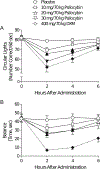Double-blind comparison of the two hallucinogens psilocybin and dextromethorphan: effects on cognition
- PMID: 30062577
- PMCID: PMC6162157
- DOI: 10.1007/s00213-018-4981-x
Double-blind comparison of the two hallucinogens psilocybin and dextromethorphan: effects on cognition
Abstract
Objectives: Classic psychedelics (serotonin 2A receptor agonists) and dissociative hallucinogens (NMDA receptor antagonists), though differing in pharmacology, may share neuropsychological effects. These drugs, however, have undergone limited direct comparison. This report presents data from a double-blind, placebo-controlled within-subjects study comparing the neuropsychological effects of multiple doses of the classic psychedelic psilocybin with the effects of a single high dose of the dissociative hallucinogen dextromethorphan (DXM).
Methods: Twenty hallucinogen users (11 females) completed neurocognitive assessments during five blinded drug administration sessions (10, 20, and 30 mg/70 kg psilocybin; 400 mg/70 kg DXM; and placebo) in which participants and study staff were informed that a large range of possible drug conditions may have been administered.
Results: Global cognitive impairment, assessed using the Mini-Mental State Examination during peak drug effects, was not observed with psilocybin or DXM. Orderly and dose-dependent effects of psilocybin were observed on psychomotor performance, working memory, episodic memory, associative learning, and visual perception. Effects of DXM on psychomotor performance, visual perception, and associative learning were in the range of effects of a moderate to high dose (20 to 30 mg/70 kg) of psilocybin.
Conclusions: This was the first study of the dose effects of psilocybin on a large battery of neurocognitive assessments. Evidence of delirium or global cognitive impairment was not observed with either psilocybin or DXM. Psilocybin had greater effects than DXM on working memory. DXM had greater effects than all psilocybin doses on balance, episodic memory, response inhibition, and executive control.
Keywords: Cognition; Dextromethorphan; Hallucinogen; Psilocybin; Psychedelic drug.
Figures





References
Publication types
MeSH terms
Substances
Grants and funding
LinkOut - more resources
Full Text Sources
Other Literature Sources

